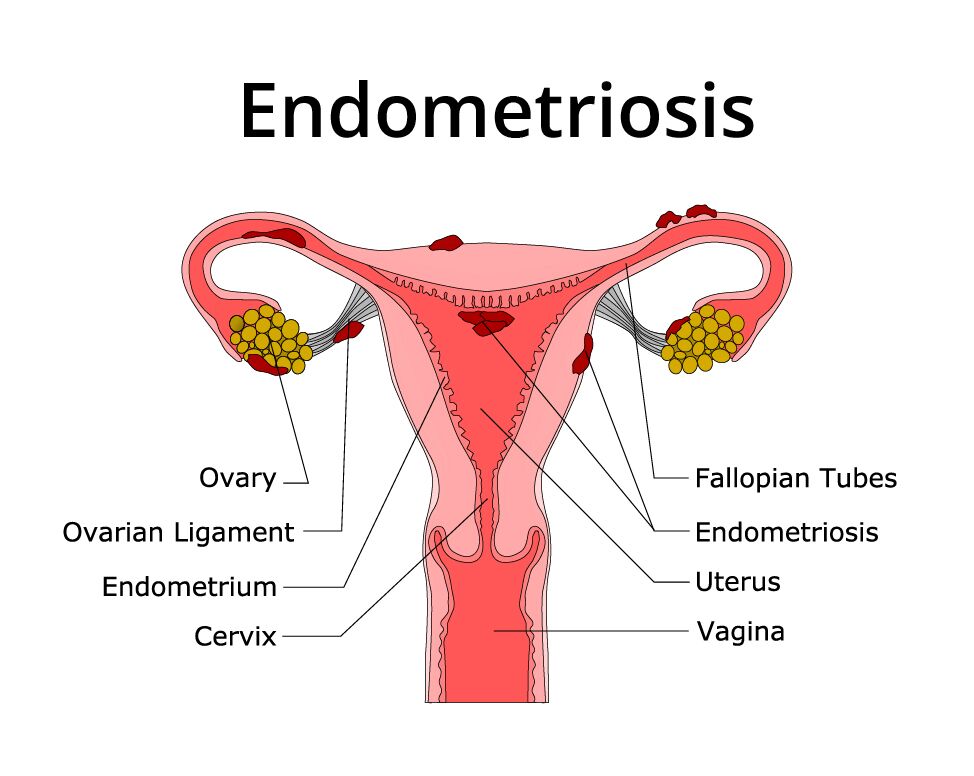Endometriosis

Endometriosis is a condition where tissue known as endometrium develops outside the uterus. Endometriosis can affect the ovaries, fallopian tubes, and the lining of the pelvis. In some rare cases, it may also be found in areas beyond the pelvic region where organs are situated.
Endometriosis can cause pain, with menstrual periods being a common trigger for this discomfort. The pain can vary in intensity and may be severe in some cases.
The symptoms of endometriosis vary among individuals and can include:
- Chronic pelvic pain, particularly during menstruation.
- Discomfort during or after intercourse.
- Pain during bowel movements or urination.
- Excessive bleeding, either during or between menstrual periods.
- Fatigue, bloating, diarrhea, constipation, or nausea.
Complications
Endometriosis can lead to serious complications, including infertility and the formation of ovarian cysts (endometriomas). Severe cases may result in adhesions, where organs stick together due to scar tissue.
Doctors use several methods to diagnose endometriosis effectively:
Pelvic Examination
A physical exam to detect abnormalities such as cysts or scar tissue.
Ultrasound
Sound waves create images of reproductive organs, identifying cysts or lesions.
Magnetic Resonance Imaging (MRI)
A detailed scan to locate and assess the extent of endometrial growths.
Laparoscopy
A minimally invasive surgical procedure that allows doctors to examine the pelvic area and remove endometrial tissue for diagnosis and treatment.
The type of treatment for endometriosis is affected by factors such as the severity of symptoms, the extent of the endometriotic deposits, and whether the patient has a desire to conceive.
Medication
For less severe cases, the patient might be prescribed with pain medication such as ibuprofen.
Hormone Treatment
Hormone treatment helps to slow down the growth and progression of endometriotic deposits through the taking of oral contraceptive pills. These medications need to be taken long-term as discontinuing them can lead to symptom recurrence.
Surgery
If the patient suffers from significant pain and/or infertility, surgery to remove the endometriotic cysts and deposits would be necessary. The procedure is usually performed through laparoscopy. For more severe cases, traditional surgery may be considered. After surgery, medical treatment may be recommended for prevention of growth of endometriosis in new areas.
Endometriosis can significantly impact fertility by distorting reproductive anatomy or creating an environment unsuitable for conception. For individuals trying to conceive:
- Surgical Intervention: Removing endometriosis-related scar tissue may improve fertility.
- Fertility Treatments: In vitro fertilization (IVF) is an effective option for those struggling with infertility caused by endometriosis.
While endometriosis refers to abnormal tissue growth outside the uterus, endometriomas are ovarian cysts filled with dark, thick fluid caused by endometrial tissue. Endometriomas are a subset of endometriosis and may require surgical removal if they grow large or cause severe pain.
